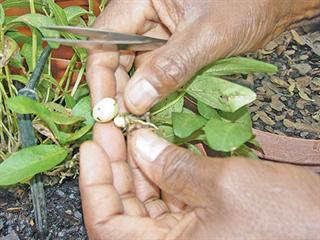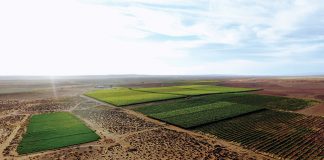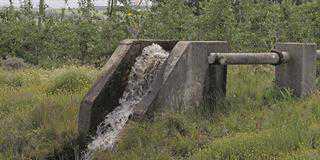
Known as the jugo bean in South Africa, nyimo in Zimbabwe and gujia or kwaruru in northern Nigeria, the Bambara is an underutilised crop plant and its genetic diversity is largely unexploited. Bambara groundnut (Vigna subterranea) is a legume crop with potential as an important part of the diet for rural households across sub-Saharan Africa. Drought-tolerant and able to withstand high temperatures, it is a nitrogen fixer, like almost all members of the Fabaceae or legume family.
Bambara is a low-demand plant that tolerates soil with low fertility and a soil pH between 4,3 and 7. Pod development takes place underground and the growth cycle is 120 to 150 days. Although this nutritious crop has a yield potential of over 3t/ha, comparable with other legumes such as the cowpea and peanut, it generally yields less than 2t/ha, mainly due to the poor soils on which it is grown.
“Although the Bambara groundnut is an indigenous African species, with numerous advantages over other legumes, the research community has not paid it any serious research attention,” says Nigerian Mohammed Mohammed, working on his doctorate in plant breeding at the University of KwaZulu-Natal’s (UKZN’s) School of Agricultural, Earth and Environmental Sciences.
According to Mohammed this is partly because of difficulties involved with hybridisation. “No improved varieties have been bred for higher yields and the crop has lingered as an ‘orphan’ or under-utilised species.” Bambara contains 70% carbohydrate, 20% protein and 10% oil, making it a good complement for cereal-based diets, he adds.
.jpg)
Landrace seed, which varies in coat colour, eye colour and pattern, hilum colour and pattern, and size, was collected from 16 African countries.
“Across Africa, the Bambara groundnut is consumed in several ways and at different stages of maturation. Young, fresh, immature seeds may be boiled and eaten as a snack; dry seeds can be made into a nutritious bean porridge. It is used in bread-making, as a type of milk and as a component of infant feeds.” According to Mohammed, Bambara is rich in iron, and the protein contains lysine and methionine, amino acids that are deficient in sorghum and maize. It is also an excellent source of vitamin B (niacin).
Landrace seeds
Farmers have selected landrace varieties, leading to a multitude of landraces with mediocre yields.“The good news is that the diversity of landraces provides breeders with a wonderful starting point to breed for resistance to pests and diseases, environmental adaptability, superior nutritional characteristics and enhanced yield potential,” says Mohammed.
He began by collecting landrace samples from seven geographical locations in Zambia, Zimbabwe, South Africa and Nigeria. These seeds showed differences in seed coat colour and seed eye (or hilum) colour and pattern. After collection, the seeds were sorted and classified. “Sorting the Bambara landraces took me five months. From 53 landraces, 353 different seed morpho-types were identified,” says Mohammed. This exercise formed the basis from which improved varieties could be developed.
“Selected seed types were evaluated in the field using morphological and molecular markers for improved performance. Each variant has genetic features that can be exploited through breeding.” A baseline survey was carried out to assess the needs of small-scale farmers. A total of 480 farmers in Kano State, northern Nigeria, were interviewed to help Mohammed identify grower preferences, such as yield, maturity and seed quality. This information will be used to initiate a breeding programme for genetic enhancement engineered to meet farmers’ needs.
Breeding the best cultivars
“We are field-testing the seed in Pietermaritzburg and using DNA technology to see how diverse the landrace varieties are,” explains Mohammed. “From this trial, the best varieties will be selected to breed superior cultivars for small-scale and commercial farmers. It does become a challenge because the small, delicate flowers of Bambara make it an exceptionally difficult plant to cross-pollinate.”
Developing a new variety can take years to complete, depending on the genetic nature of the variety. But it is worth the effort, says Mohammed. “Bambara groundnut is one of Africa’s genetic gems. It’s time this plant was recognised for its nutritional value and its agronomic advantages. With the right varieties, and improved yields, it can become attractive as a crop for both small-scale and commercial farmers,” Mohammed concludes.
Phone Mohammed Mohammed on 073 7393 501 or email [email protected].













